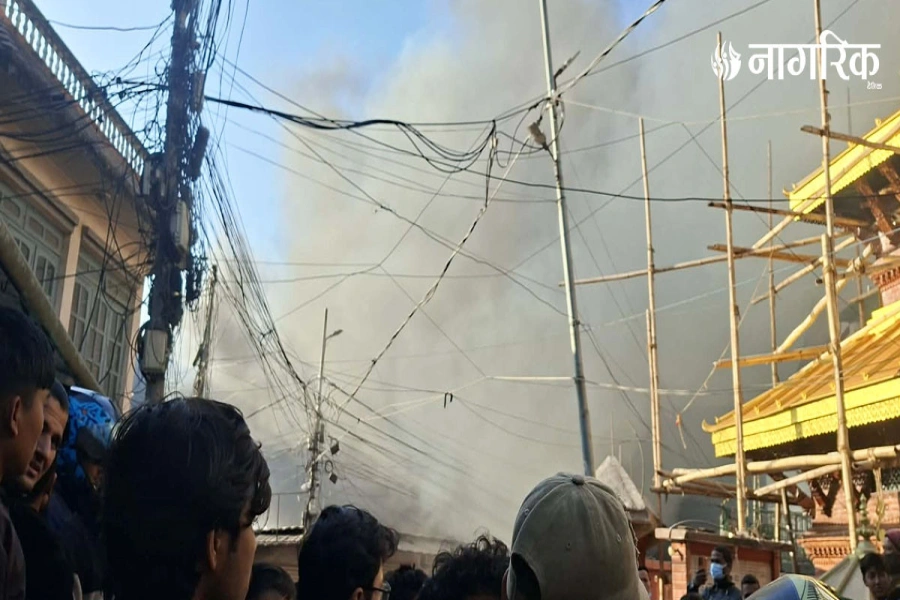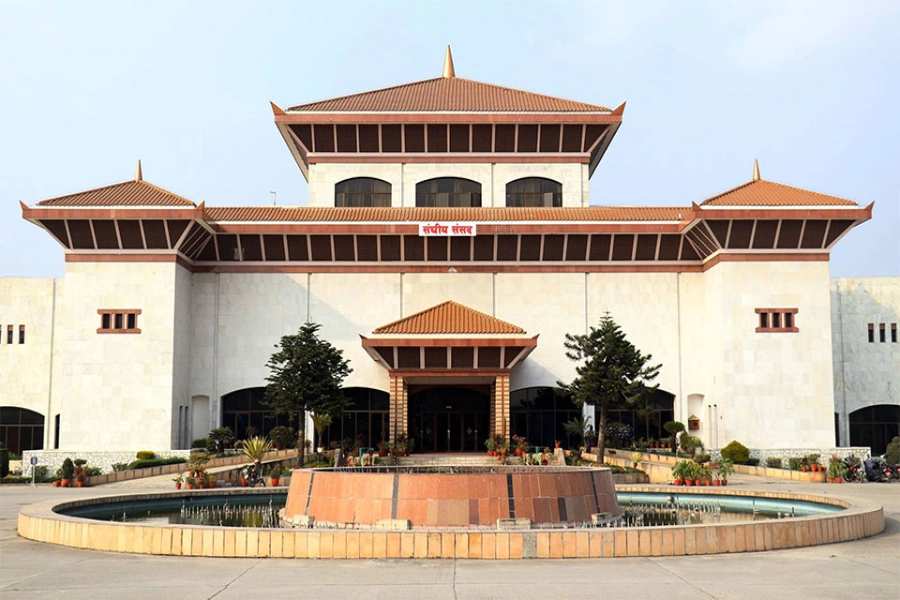The effects of climate change were visible on the mountain slopes of Baadasur while walking through the natural trail on a hiking trip at the beginning of January. The Rhododendron, which normally starts blooming in the second week of February and lasts until April under regular climatic conditions, is now observed blooming in the middle of winter. This anomaly indicates the adverse effects of climate change due to global warming. During a four-day official visit to Nepal at the end of October 2023, United Nations Secretary-General Antonio Guterres visited Pokhara, a popular tourist city, and reached the Annapurna Base Camp with the intention of observing the impact of climate change on the mountains.
After visiting the base camp in November 2023 and observing the consequences of the adverse effects of climate change, Secretary-General Antonio Guterres expressed dismay and alarm over the melting of ice on the slopes of the mountains and glaciers. He stated that the world should end the fossil fuel age to curb what he sees as a devastating level of glacier melting in the Himalayan mountains due to global warming. Addressing the House of Representatives, the UN Secretary-General said, “I witnessed the devastating effects: swollen lakes burst, rivers and seas rise, and cultures are threatened. Mountainsides are exposed, inflaming the risk of rockslides, landslides, and avalanches.” Nepal has already lost one-third of its glaciers, and the remaining one-third is in the process of melting by the end of this century.
In his address to COP28 in Dubai, the Prime Minister of Nepal acknowledged the Himalayas as the foundations of human civilization, ecosystem, and biodiversity, as well as the lifeline of billions of people downstream. He highlighted climate-induced disasters such as landslides, floods, wildfires, glacial lake outbursts, drought, etc, and emphasized initiating a dialogue on mountain and climate change to address the suffering of mountainous communities and find workable solutions. Nepal has already lost one-third of its glaciers and is on track to lose another one-third by the end of the century, depriving fresh water to mountain people and downstream. The Prime Minister also demanded grants for the injustices inflicted upon vulnerable nations, including Nepal, which is being punished without any fault of its own.
Experiencing the harsh conditions and erratic behavior of climate, induced by human activities, has become a regular phenomenon. As reported in the news, 2023 AD is the warmest in Nepal in 13 years and the second warmest in the past 42 years. Similarly, a report released by the European Union's Copernicus Climate Change Service (C3S) for 2023 backs up the scientific consensus that 2023 was the hottest year on record.
SHIFT for Our Planet: Youths urge authorities to make climate j...

With changes in temperatures, precipitation patterns have also changed. According to the Department of Hydrology and Meteorology, the country received lower-than-normal precipitation, with the average maximum temperature rising above 0.7 degrees Celsius between January and October last year. A report prepared by the department states that during the same 10 months, the country received 11 percent lower-than-normal rainfall, the sixth lowest precipitation since 1981. The groundwater level is plummeting in Tarai, and shallow tube wells have to go further deep to extract water.
Evidence of extremes and climatic disasters is observed, such as heatwaves, heavy precipitation, droughts, and tropical cyclones. Drying of streams, aquifers, and springs has become a common occurrence in the mountains and low-lying lands. The rampant use of community and public landholdings, in the name of development initiatives without proper planning, technological survey, and feasibility study, using heavy machines to dig out the soil and break the hard rock, has badly affected the local environment and ecology.
Villagers and vulnerable communities, who historically contributed the least to the current climate change, are disproportionately affected, whether they are least developed countries or inhabitants of those nations. In Nepal, people are internally migrating from where they have been living for generations due to shortages of drinking water and drying up of water sources. Erratic weather conditions and natural calamities have common features, such as landslides, flash floods, wildfires, irregular rainfall, etc. In some cases, the whole village is emptied, and all residents have migrated downstream where they can find plenty of water for drinking and irrigation for their farmlands. Not only in Nepal, but its global effects are also visible, as climate change intensifies heatwaves, droughts, and wildfires across the planet, whether it is wildfires in Australia or the United States.
Economic damages from climate change have been detected in climate-exposed sectors, such as agriculture, forestry, fishery, energy, and tourism. Individual livelihoods have been affected through the destruction of homes and infrastructure, loss of property and income, human health, and food security.
Since the burning of fossil fuels and the production of methane are the major contributors to global warming and the greenhouse gas effect, finding alternative green energy would be the lasting solution to prevent the earth from climatic disasters. To prevent rising temperatures, heavier rainfalls, strong winds, and longer and more frequent dry spells, a collaborative approach and help from industrialized and advanced nations are needed to work collectively to attain the goal of net-zero carbon emissions.
Realizing the sense of catastrophic results shortly, coastal countries have been consistently lobbying and advocating for a mitigation action plan to prevent the adverse effects of global warming and control temperature rise, so that coastal cities could be protected from rising sea levels. According to the Copernicus Climate Change Service, in the worst-case scenario, as global warming melts ice sheets, mean sea levels will rise by more than 1 meter by the end of 2100 AD and increase to 2 meters by 2150 AD. It is, therefore, naturally worrying for coastal cities and nations to take preventive measures.
In this context, the Paris Agreement and Kyoto Protocol are major international declarations toward climate initiatives. The Paris Agreement of 2015 has set a milestone in this regard with the consent of 196 countries attending and signing the agreement, placing it as a legally binding international treaty. Nepal, being a party to the agreement, is fully committed to the principles and programs stated in the agreement. This agreement on climate change aims to hold “the increase in the global average temperature to well below 2 degrees Celsius above pre-industrial levels” and pursue limiting the temperature increase to 1.5 degrees Celsius above pre-industrial levels. It is, therefore, the obligation of all parties or nations to sincerely abide by the agreement and take initiatives individually and collaboratively to meet the targets. Failure to address the climate crisis with urgency will worsen until we transition away from fossil fuels and reach net-zero emissions. For this, collaborative efforts to find and develop alternative energy sources, most reliably renewable, green, and clean, should be the concerted focus. Nations should impose carbon taxes to discourage and reduce reliance on burning fuel for energy and promote electric vehicles.
Nepal needs to take the lead and form a team of mountainous countries, mainly China, India, Pakistan, Iran, Afghanistan, Nepal, Bhutan, and Myanmar alike, to raise the issues of mountains and climatic effects in any international forums, parleys, assemblies, conventions, or diplomatic gatherings. Similar to cities in coastal areas, which are collaboratively raising issues in important meetings, seminars, and international conventions with united voices, the mountain countries need to be more inclined and concerned in this regard. After the Maldives’ underwater meeting to draw attention to the rising sea level due to global warming and melting ice, Nepal also took the initiative to hold a cabinet meeting of the Government in December 2009 at the base camp of Mt Everest to draw attention to the international community to minimize the negative impact of climate change, as the ice at the top of the mountains is thinning and lakes are bursting. After a hiatus of 14 years, Nepal is nowhere to organize such events again or any significant initiatives alike. This shows Nepal’s dismal interest in climatic issues. Speaking and delivering speeches at international forums would not produce the desired results, which demand action rather than rhetoric, and the implementation of a climate mitigation action plan.


































